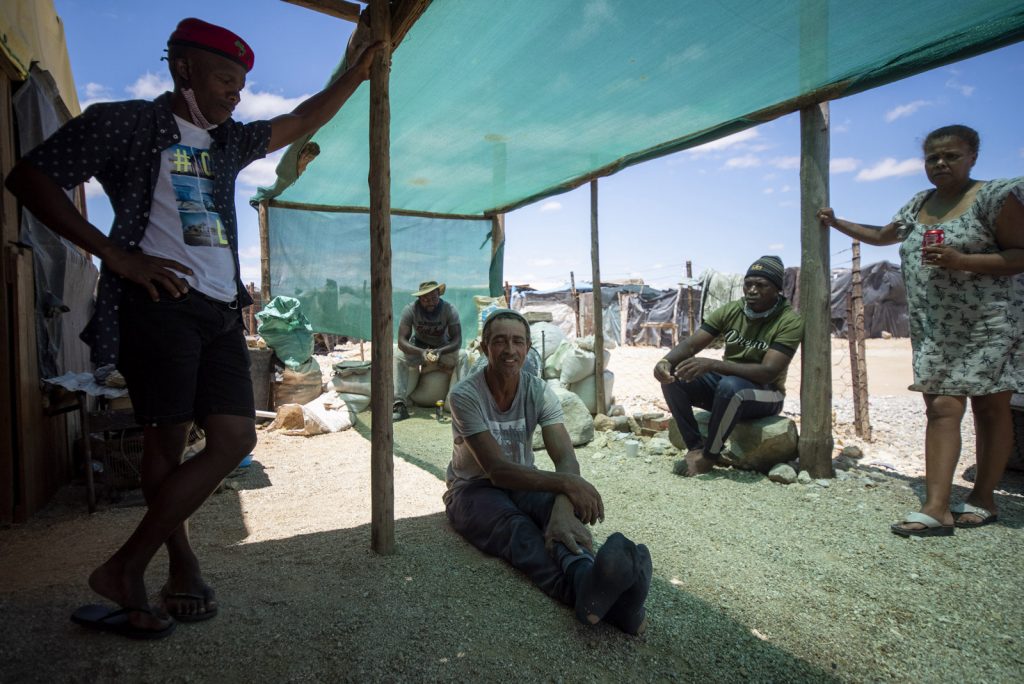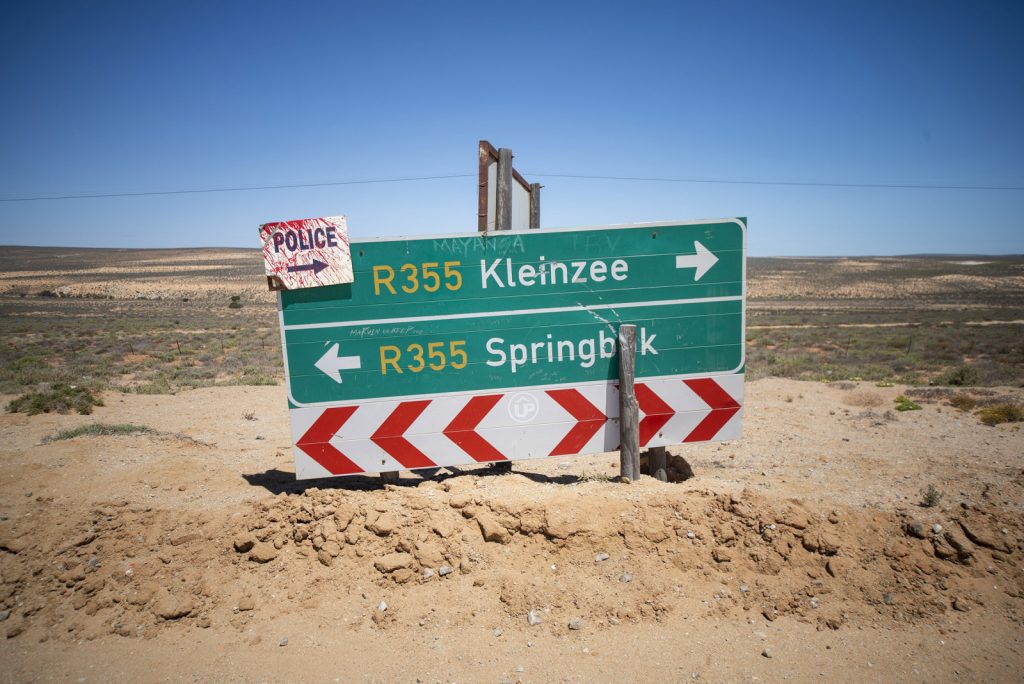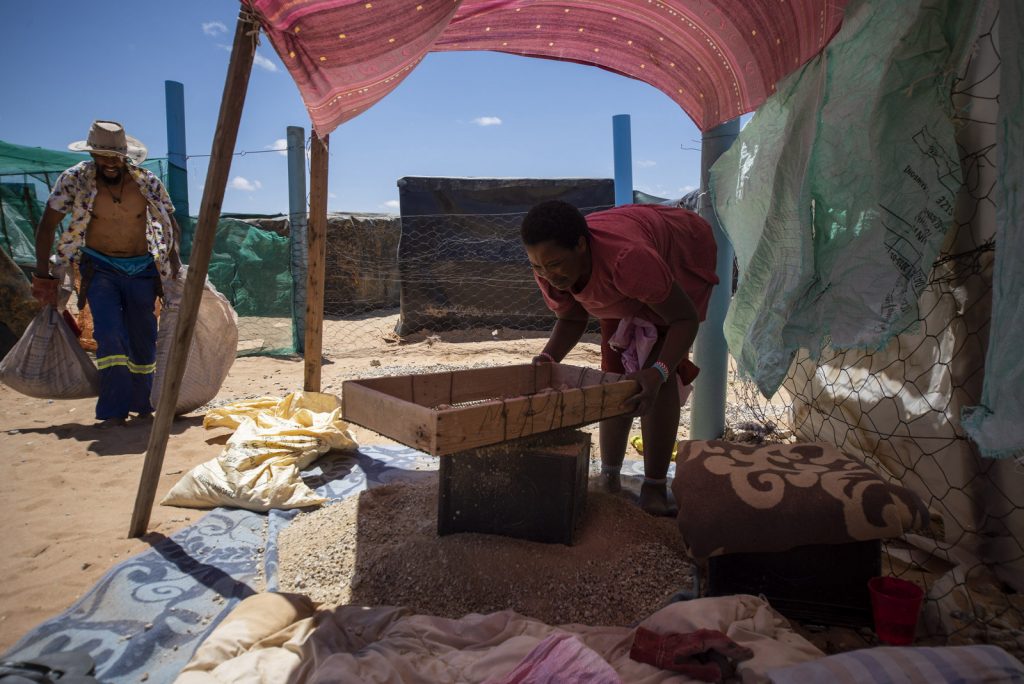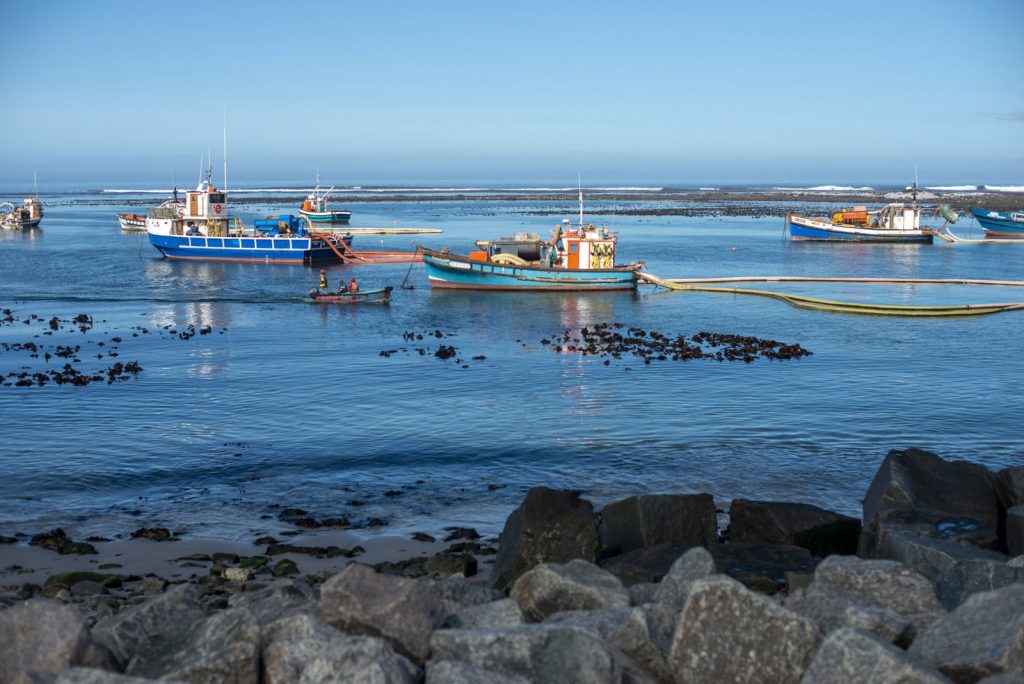South of the Orange River lies the Northern Cape, whose barren landscapes are painted with red Kalahari sand. At sunset, a combination of vivid orange and red fills the skies. At night the celestial sphere covers the region in a soft glow, and a heavy silence befalls the semi-desert plains.
But don’t be fooled by the beauty. Life here is hard for the residents.
“Welcome to the world of struggle,” greets Brian (surname withheld), from underneath a makeshift shadow net that blocks out the sweltering sun, but not the heat, at Bontekoe mine, about 70 km south-east of the province’s small town of Port Nolloth.
“This land belongs to Komaggas, Buffelsrivier, Plaas 200. It is the community’s land. For a lot of years we have been chased off this land, like animals. We are illegal diggers on our own land.”
Surrounding Brian’s makeshift home, where he stays with his wife, are dozens of similar informal structures housing hundreds of people, the majority of whom are also illegal miners.
 For decades, mining company De Beers extracted billions in diamonds along the Northern Cape Coast leaving a scarred landscape and impoverished local communities. Since abandoning their operations many diamond prospectors or illegal miners, some formally employed by De Beers, have begun dangerous artisanal mining to try to put food on their tables. All photos by David Harrison
For decades, mining company De Beers extracted billions in diamonds along the Northern Cape Coast leaving a scarred landscape and impoverished local communities. Since abandoning their operations many diamond prospectors or illegal miners, some formally employed by De Beers, have begun dangerous artisanal mining to try to put food on their tables. All photos by David Harrison
“Ek probeer oek maar leef van dag tot dag (I’m also trying to live from day to day),” Brian tells the Mail & Guardian in Afrikaans.
“I’m not ashamed of the work I do here. Everyone has a daily need, and that is bread. So I do not feel like I’m stealing. The law made me a thief.”
“I’m formed from soil, so I will always turn to soil.”
Brian and his wife, Marita, run a thriving tuckshop where they sell food and beverages to miners workers working at abandoned mines that lie within easy reach of the community.
Brian also mines for diamonds.
“This is a newborn town, with newborn opportunities, and I will not let opportunities go by again,” he says. “If I dig a diamond with my two hands, and I use my energy and find a diamond, is it not a well-deserved earning?”
He is fed up with police carrying out frequent raids at the abandoned mines and says if the community needs to defend their land by fighting, they will.
His wife chips in: “I’m willing to take a bullet for this matter.”
Another man who did not give his name, but who his neighbours referred to as Daniels, says he has been digging for diamonds since the 1980s. He started when he was 13 years old, also the age when he found his first stone.
“Our diamonds have been taken away from us, they [the government] took our rights. We have to mine on land belonging to us, illegally,” he says. Daniels says he also farms on land the government gave back to the community after prospecting efforts yielded no significant findings.

For decades, small-scale opportunists, major corporations and the government have claimed rights to land that is rich in minerals across the Northern Cape.
It is not only diamonds that are mined in the province.
Davi Clark is a deep-sea miner who has a vessel and concession rights to mine in the ocean on land belonging to state-owned mining company Alexkor. It was on his vessel that a 23-carat pink diamond was found about two decades ago. Back then, it was valued at more than R160-million.
“Deep-sea mining is only one type of mining occurring in the ocean space. Prospecting and mining for diamonds and heavy mineral sands is taking place on coastal land, beaches and in the nearshore environment’ says Merle Sowman, a professor at the department of Environmental and Geographical Science at UCT.

Prof Merle Sowman and Dr Jackie Sunde from the One Ocean Hub research group at UCT, together with GIS expert Rio Button, have been tracking, recording and mapping information on prospecting and mining, as well as oil and gas applications on the west coast of South Africa for the past two years.
Of concern is the significant increase in the number of applications for prospecting and mining along the west coast and the absence of an environmental planning framework to guide decision-making, argues Sowman.
She adds, the Department of Mineral Resources and Energy, which is responsible for authorising prospecting and mining applications, assess applications in isolation and does not consider the cumulative impact of all these applications and operations on the environment, and communities that depend on the coast for their food and livelihoods.

“You cannot look at all these applications on an ad-hoc basis, and keep approving these Individual projects without considering the cumulative impacts. What we need is a moratorium on all new prospecting and mining applications on the west coast of South Africa while a strategic environmental assessment is being undertaken by an independent team of environmental experts”.
Sowman explains that wall-to-wall mining along the west coast is likely to result in impacts on our scarce water resources, on biodiversity, areas of conservation value, cultural resources as well as access to coastal area and fisheries resources and areas. An increase in truck use to transport minerals affects the quality of roads, creates dust and air pollution and needs to be assessed across all these projects as part of a strategic assessment.

Applying for mining or prospecting permits is a timely and costly operation, one many people cannot afford. The lack of funds and skills to complete lengthy application forms leads to hundreds of informal or artisanal miners resorting to illegal mining.
Further to this, minimal capital is needed to comply with the requirements of the current small-scale miners policy under Section 27 of the Mining Petroleum Resource Development Act, which recognises the need “to promote local and rural development and the social upliftment of communities affected by mining”.
Today, heaps of unearthed soil across the province are what remains of former excavation areas. At these abandoned open mines, illegal miners hope to find the next big stone. Children and adults alike know where to find open mines and can easily identify them: Nuttaboy, Bontekoe, Sandkop, Hondeklip Bay, the list goes on.
With a chisel and a shovel, anyone can become a miner.
In a town like Port Nolloth, employment opportunities are scarce and coming from low-income households means that young people do not have an opportunity to further their studies after high school. In communities riddled with poverty and substance abuse, many people, including children as young as 13, end up seeking diamonds.
 Port Nolloth harbour
Port Nolloth harbour
After the Covid-19 pandemic struck, the Northern Cape saw an influx of illegal miners from other parts of the country. Locals who insist that the land they mine belongs to them now have to share it with others, often sparking racial tensions.
“Each one does what they want. There are no more structures,” complains Brian. “Everyone [digs] their own hole. If there could just be a plan and structure, it would be safer.”
The lack of proper planning of where tunnels are burrowed, he notes, could easily cause a collapse. Such occurrences have led to loss of life in the past. Ten people died at Bontekoe in 2012 and more recently, three miners were killed and 10 rescued when a tunnel collapsed at Nuttaboy this April.
From under his shadow net at Bontekoe, Brian has a simple plea. He believes that if the informal miners could be acknowledged by the government, a safe environment and a structure beneficial to all could be put in place to allow them to make a decent living.
Officials from the department of mineral resources and energy told the M&G that the department operates a framework to support small-scale miners in all South African provinces. The government is also working on the development of an artisanal and small-scale mining policy which would remove some of the red tape that has impeded informal miners. Consultations were undertaken in the areas of Namaqualand, Port Nolloth, Kathu and Gamagara in the Northern Cape to solicit public input.

In the meantime, the illegal miners continue to toil to eke out a meagre living. A few hundred metres from Brian’s tuckshop, the sound of vibrant music echoing off sandy hills and food tents belies a hard life for the residents.
There is no running water, no health facilities nearby, no safety structures and no houses. Women wear long skirts to preserve their modesty when they squat in open fields to relieve themselves.
The search for the diamonds is also not for the fainthearted. To reach them, explains a miner, you need to reach the belt. And to reach the belt you must pull yourself down an 18-metre hole, pushing away your fears and repeating to yourself: “As long as I just find something.”
* In this four-part series, War for Diamonds, the complex mining industry in the Northern Cape is explored largely through the lens of illegal miners who feel their efforts to obtain legal mining permits have been futile. These informal miners are to a large extent separated from illegal miners who work for syndicates and have no intention to mine legally. Without justifying illegal mining in any form, the series hopes to bring forward voices of Namaqualand, a place often forgotten by many.
[/membership]